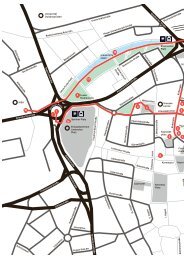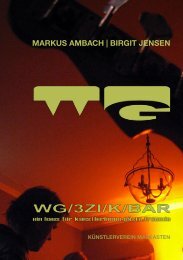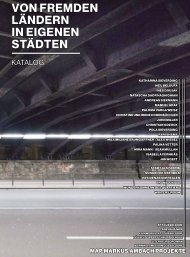B1|A40 THE BEAUTY OF THE GRAND ROAD
DIE SCHÖNHEIT DER GROSSEN STRASSE 2014 EINE AUSSTELLUNG IM STADTRAUM DER A40 VON DUISBURG BIS DORTMUND 14.06.2014 – 07.09.2014 MAP MARKUS AMBACH PROJEKTE URBANE KÜNSTE RUHR (HG.) WIENAND
DIE SCHÖNHEIT DER GROSSEN STRASSE 2014
EINE AUSSTELLUNG IM STADTRAUM DER A40 VON DUISBURG BIS DORTMUND
14.06.2014 – 07.09.2014
MAP MARKUS AMBACH PROJEKTE
URBANE KÜNSTE RUHR
(HG.)
WIENAND
You also want an ePaper? Increase the reach of your titles
YUMPU automatically turns print PDFs into web optimized ePapers that Google loves.
pretations, as Kolding emphasizes: “I have come to appreciate how, for<br />
instance, a man upside down can be a comment on power, on the use of<br />
space in a very concrete sense, a literal expression of seeing things from<br />
a new perspective, or how it can express a kind of existential feeling.“ 7<br />
The major trait shared by all collages – apart from their reduction to<br />
black-and-white values – is found in their relative isolation. “The space<br />
of non-place,” Augé states, “creates neither singular identity nor relations;<br />
only solitude, and similitude.” 8 Thus all the installed works correspond<br />
to some degree to that which is already there; the tiger, for instance,<br />
will be perceived as in some way connected to the lawn behind<br />
the guardrail as its potential habitat, and the umpire positioned in front<br />
of an underpass like a doorman will be seen in the context of a colorful<br />
figurative graffiti on the tunnel wall. Without doubt they are contained<br />
in situations which also include the beholders. Yet there is no coherent<br />
narrative, no superlative meaning (nor can there be, in view of their heterogeneous<br />
sources and designs) which they can offer up to them. Their<br />
anti-illusionistic effect is, moreover, enhanced by their two-dimensionality<br />
and their shadowy-abstract backsides. Thus they are reflecting<br />
the non-place they are positioned in while using it in their idiosyncratic,<br />
subjective way without attempting to conjure up a utopian mirage before<br />
the eyes of the real-life residents and passers-by at the Frillendorfer<br />
Platz.<br />
BARBARA HESS<br />
1| Chtcheglov, Ivan: “Formulary for a New Urbanism“, in: Internationale Situationniste<br />
No. 1, Paris 1953, in: [09.07.2015].<br />
2| Henri Lefèbvre on the Situationist International. Interview conducted and translated<br />
by Kristin Ross in 1983, in: October No. 79, Winter 1997, in: [09.07.2015].<br />
3| For more information on this subject and on Debord’s definition of “psychogeography“,<br />
see: Dziewior, Yilmaz: “Psychogeographie“, in: Jakob Kolding. exh. cat.,<br />
Kunstverein in Hamburg, Stuttgart 2001, p. 4–14; ill. on p. 21.<br />
4| Fried, Michael: “Art and Objecthood“, 1967, in: http://bcnm.berkeley.edu/<br />
nwmedia201/readings/FriedObjcthd.pdf, p. 3.<br />
5| Morris, Robert: “Notes on Sculpture“, in: Artforum, Vol. V, No. 2, Los Angeles 1966.<br />
6| Augé, Marc: Non-Places. Introduction to an Anthropology of Supermodernity,<br />
London/New York 1995.<br />
7| Kolding, Jakob: “Like Shadows. A Conversation between Jacob Proctor and Jakob<br />
Kolding”, in: Jakob Kolding, Shifting Realities, exh. cat., University of Michigan<br />
Museum of Art, Zürich 2001, p. 21–25, here: p. 22 f.<br />
8| See note 6, here: p. 103.<br />
160












